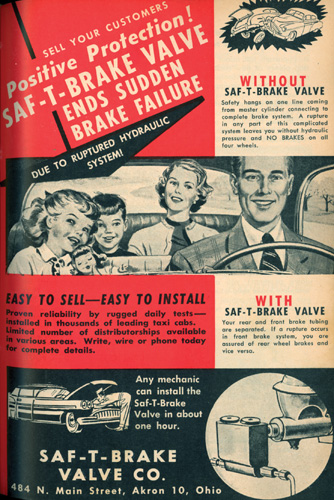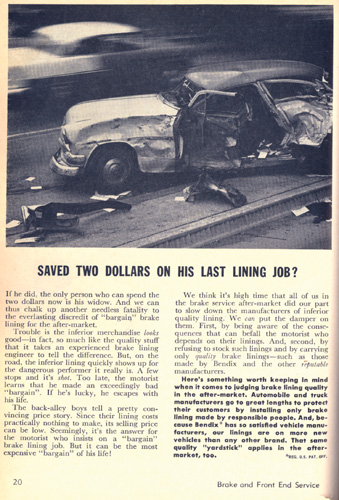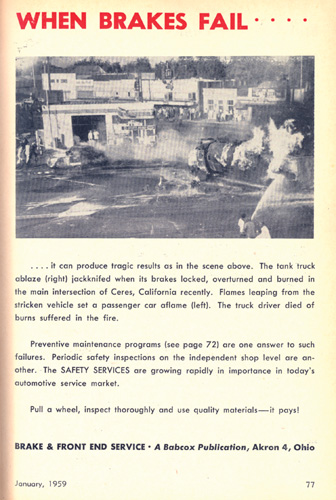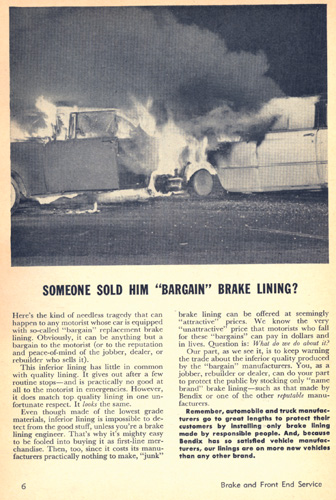Has the motoring public changed so dramatically in the past 50 years that they do not want to be confronted with images of mangled people and vehicles? Or, have our roads and vehicles become safer?
Last year, 33,963 people died in traffic crashes in the U.S., the lowest total since 1954, according to the Department of Transportation. The fatality rate of 1.16 deaths per 100 million vehicle miles traveled was the lowest since the government started tracking it in 1966.
It seems the American consciousness is more concerned with cell phones, drunks and texting instead of mechanical brake failures. But, it also seems the motoring public is more concerned with losing parts of their wallets than a limb.
 Over Easter vacation I had a chance to visit with family and old friends. I have always been known as the “car guy” and consulted by people seeking advice. Typically, it is a question about a squeak, rattle or other annoying noise a vehicle is making. But, it seems lately the focus of the inquiries are more of an economic nature than about safety and performance related issues.
Over Easter vacation I had a chance to visit with family and old friends. I have always been known as the “car guy” and consulted by people seeking advice. Typically, it is a question about a squeak, rattle or other annoying noise a vehicle is making. But, it seems lately the focus of the inquiries are more of an economic nature than about safety and performance related issues.
A friend who leases a 2007 Dodge Caravan asked me about a brake problem he was having. He said that occasionally the pedal was going to the floor. His first question out of his mouth was, “How much is this going to cost me?” He did not ask if it is safe for him to drive with his three small children in the back.
You have to understand my friend is one of those great parents that checks websites to find out what car seat, playpen or stroller has been recalled for maiming or killing a small child. But, this is also coupled with a streak of cheapness.
I asked him when it occurs and how long it has been happening. He said at least twice a day on his drive to work on the freeway, and for about a month.
 “So, how much is this going to cost me?” he repeated as if all car guys had some sort of secret price sheet in our heads. “How much is your family worth?” I asked. This is where polite conversation ended.
“So, how much is this going to cost me?” he repeated as if all car guys had some sort of secret price sheet in our heads. “How much is your family worth?” I asked. This is where polite conversation ended.
Instead of answering the question about the value of his family, he fired back, “I saw on the internet about other owners having the same problem.” He had to go there.
I told him that he could probably find guy who also has Chuck E. Cheese Pizza vomit in his Stow n’ Go seating well that he can’t get out no matter what he tries. The hostility was reaching DEFCON 3.
 The Internet provides us with a bounty of information on how to repair today’s complex vehicles (typically requiring a user name, password and credit card number). But, we live in fear of customers thinking they can fix their vehicle with a Google search and a trip to the parts store, or the ones that search the internet for ways how to out smart shops.
The Internet provides us with a bounty of information on how to repair today’s complex vehicles (typically requiring a user name, password and credit card number). But, we live in fear of customers thinking they can fix their vehicle with a Google search and a trip to the parts store, or the ones that search the internet for ways how to out smart shops.
The internet can be a virtual “shoulder to cry on” for drivers with similar car problems. If they search their problem they can find a forum of people who are just as confused, ignorant and scared. Some of these threads can go on for pages with little or no technical help.
With our conversation going downhill quickly, I asked him why he had not brought it to a shop or at least a dealership. He said that he did not want to get “screwed” by having to pay for something he did not need or have to pay for before his lease was up.
It is unthinkable to me he would risk the safety of his family in order to save a few dollars. It was clear the fear of losing money has replaced the fear of losing life and limb with the driving public.
There is a solution, just like how Pepsi has brought back “Throwback” versions of their products, the aftermarket needs to do a throwback to an age when mangled cars and images of children chasing a ball into the street were featured prominently in friction material advertisements.
 Forget the images of kids getting out of an SUV for soccer practice or a women in a pantsuit sitting comfortably in a waiting room while her car is fixed, I want to see gore in ads that would make any personal injury lawyer blush. Major chains should replace catchy price-based jingles with the sounds of screeching brakes and car crashes in their ads.
Forget the images of kids getting out of an SUV for soccer practice or a women in a pantsuit sitting comfortably in a waiting room while her car is fixed, I want to see gore in ads that would make any personal injury lawyer blush. Major chains should replace catchy price-based jingles with the sounds of screeching brakes and car crashes in their ads.
I know this may be going a little far, but for far too long we have been trying to create warm fuzzy feelings about brake repair, shops and parts that are not there in the first place. The industry has forgotten that we prevent people from hitting stuff that can kill them.









